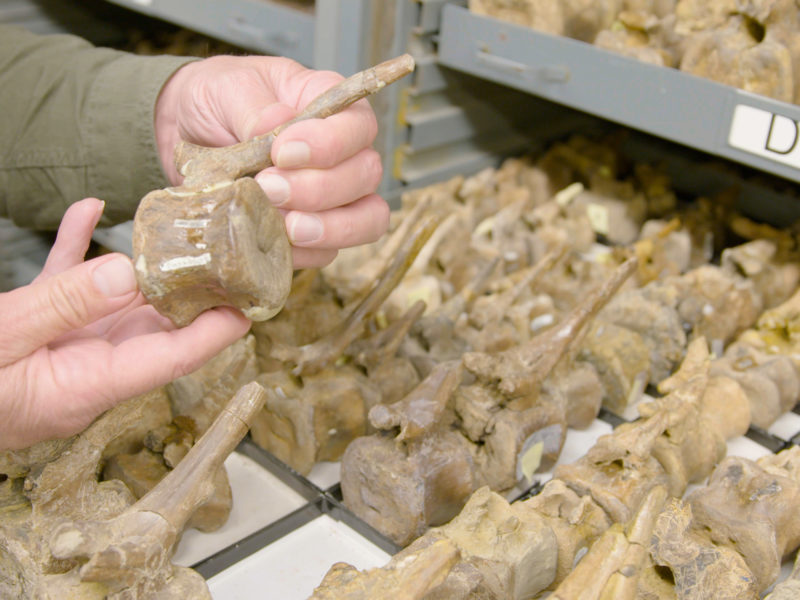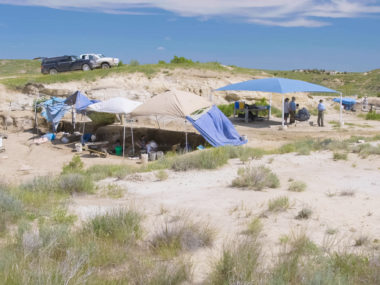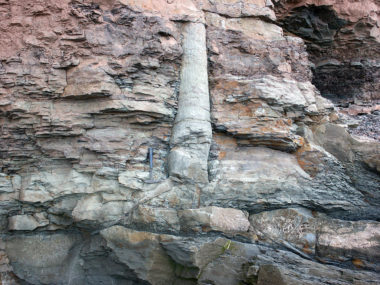Soft tissues and original organics found in dinosaur bones is a controversial topic within the secular scientific community for obvious reasons. How can original tissues survive for two hundred million plus years? This is especially problematic given multiple studies that conclusively limit soft tissue preservation to about 700,000 years for robust proteins and 100,000 years for DNA, given a dry, moderate paleo-temperature of about 10 – 15°C (Buckley and Collins 2011; Allentoft et al. 2012).
The following article has been reblogged with permission from Creation Unfolding. The views expressed reflect those of the author, and not necessarily those of New Creation.

A few recent studies, however, have suggested that original soft tissues can survive deep time if exposed to post-mortem glycoxidation and lipoxidation mechanisms (Wiemann et al. 2018). These bio-chemical reactions are not new and are presently at work within our bodies altering our DNA and proteins into Advanced Glycoxidation End Products (AGEs) and Advanced Lipoxidation End Products (ALEs).
Simplistically, sugars and lipids found within our tissues can bind, for example, to proteinaceous amino acids (this is called cross-linking) using glycoxidation and/or lipoxidation pathways. These “new” molecules are called AGEs and ALEs, in that they are the “end products” of these reactions. Advanced Glycoxidation End Products and ALEs damage tissues by altering their structure, often causing them to become hard and brittle. It is for this reason that doctors warn humans about consuming AGE and ALE-rich foods (you guessed it, burgers, fries, processed food, etc.).
It turns out that glycoxidation and lipoxidation reactions can occur even after an organism dies. This is called non-enzymatic glycoxidation and lipoxidation because the chemical reaction occurs without the aid of enzymes. In other words, dead tissues can continue to change after death! Given the right conditions, AGEs and ALEs can replace large fractions of original protein structures, leaving behind “non-proteinaceous” scaffolds that resemble the original proteins—much like a bone that turns into rock; what is left is the “bone impression,” but not the bone. In other words, fossil tissues that have been exposed to advanced levels of glycoxidation and/or lipoxidation processes might only contain remnants of the original protein molecule, even though they retain the original organic shape.
Those antagonistic of creationism are now using this model to explain soft tissue preservation over deep time. Consider these remarks from recent social media posts on this topic:
“Collagen is a type of molecular arrangement. What she [previous studies by Mary Schweitzer et al.] found were traces of this molecule.” And this: “No ‘soft tissue’ has ever been found. What has been found is chemical protein remnants.”
Even the popular science media has been convinced. The title of a LiveScience article discussing AGEs and ALEs, for example, reads: Controversial T. Rex Soft Tissue Find Finally Explained.
So, what are creationists to make of these claims? Well, spoiler alert here, although the research on AGEs and ALEs is robust, its application to preservation for all soft tissues over deep time is not. In other words, if we only find one example of soft tissues preserved without the aid of glycoxidation and/or lipoxidation, then all bets are off. And, of course, that is precisely what we do find (discussed below). But first, let’s take a closer look at the research associated with AGEs and ALEs.

Image Credit: Allie_CaulfieldDerivative: User:MathKnight – File:LA-Triceratops mount-1.jpg (by Allie_Caulfield ), CC BY-SA 3.0, https://commons.wikimedia.org/w/index.php?curid=38858643
Wiemann et al. (2018) showed that dinosaur soft tissues liberated from dinosaur bones were highly altered by glycoxidation and/or lipoxidation, with greater than 50%, but perhaps as high as 80% of the original proteins being replaced by AGEs and ALEs (see their supplementary material and Wiemann’s website). According to Wiemann et al., the bonds that exist within AGEs and ALEs, unlike the peptide bonds that exist between non-modified amino acids, are hydrophobic (water-fearing). This means that the bonds are supposedly impervious to degradation by water and/or microbes. This prompts the researchers to say: “This explains the preservation of fragile soft tissues in certain chemical environments through deep time.”
It is, of course, comments such as this that are picked up by anti-creationists. The most important piece of data ignored by these critics, however, is related to the properties of these “non-proteinaceous” molecules—they are brittle. All the samples from Wiemann et al. lacked elasticity, a property conferred to proteins by organic elastin. Although AGEs and ALEs mimic the “shape” of the protein, they cannot mimic the “role” of the proteins they replace. The samples studied by Wiemann et al. contained greater than 50% AGEs and ALEs. Their fragility is, therefore, diagnostic of protein-wide lycoxidation and/or lipoxidation. Yet not all dinosaur soft tissues are brittle and fragile. There are multiple examples of soft tissues liberated from bones that retain almost perfect elasticity. These samples are also often clear; a fact that, according to Wiemann et al., suggests a reducing environment not suitable for the formation of AGEs and ALEs.
Multiple examples of soft, flexible, pliable, and clear soft tissues liberated from dinosaur bones can be found in many of those papers authored by Mary Schweizer and her team between the late 90s till the present. Consider a paper published just this year by Bailleul et al. (2020). In this paper, Schweizer and her team found soft tissues in clear cartilage from an 80 million year old duck-billed dinosaur. Alluding to the non-oxidative state of the cartilage, the team say, “Unlike dinosaur osteocytes that often present a reddish hue due to iron inclusions [21], Hypacrosaurus chondrocytes are transparent (Fig. 4A and B), suggesting a different preservation mode.” In other words, glycoxidation and lipoxidation, and thus AGEs and ALEs, were not involved in the preservation of these soft tissues. But it gets even more interesting. Not only did the team find soft tissues, they found shorts chains of DNA, at least six base-pairs long, but perhaps longer.
This is stunning. According to actualistic studies, DNA should be broken down into single base pairs after only 100,000 years at low temperatures of about 15°C (Allentoft et al. 2012). Since this dinosaur lived and died in an environment that experienced temperatures above 30°C, and since it was originally buried in thousands of feet of sediment that experienced a high geothermal gradient of about 30°C per 3000 feet (Morgan and Scott 2014), the DNA should only have lasted hundreds or perhaps thousands of years.
So, what does this mean for the study by Wiemann et al. (2018)? Well, nothing really. This study strongly suggests that dinosaur soft tissues can be replaced by AGEs and ALEs, and thus serves as one of many possibilities for the preservation of soft tissues. Anti-creationists, however, cannot use this study to justify their belief in deep time. In order to do that, they would have to proffer solutions to explain truly elastic soft tissues in dozens of other examples. This solution is still forthcoming, leaving the interpreter to consider the simplest explanation—earth’s biosphere is not millions or billions of years old.
Wiemann’s study also has its limitations:
The sample number for Mesozoic fossils producing soft tissues is extremely small—a total of four Mesozoic animals produced soft tissues. This is a very small sample number.
Secondly, even though glycoxidation and/or lipoxidation alter the structure of proteins, they still retain long chains of amino acids that are susceptible to hydrolysis. This is especially true for slightly altered proteins (see Boatmann et al. 2019). Yet dinosaur bones were buried in a hot, Mesozoic climate (greater than 30°C). Eventually, these bones reached almost 10,000-foot depths in North American basins where the geothermal gradient increased temperatures to at least 100°C (Morgan and Scott 2014). Not only does the study by Wiemann et al. not put any numbers on the preservation potential of proteins altered by AGEs and ALEs, it makes no attempt to account for extenuating taphonomic conditions that encompass deep burial, high temperatures, and abundant water over deep time.
Finally, Weimann et al. (2018) were able to induce glycoxidation and lipoxidation in extant soft tissues. These modern soft tissues accumulated AGEs and ALEs extremely rapidly. This suggests that AGEs and ALEs replace normal amino acids at a measurable rate. Given 80 million years, shouldn’t all the Mesozoic tissues have been replaced by AGEs and ALEs? It’s astonishing that any of the original organics remain at all.

By Etemenanki3 – Own work, CC BY-SA 4.0, https://commons.wikimedia.org/w/index.php?curid=64851675
If actualistic studies limit preservation of Collagen to 700,000 years at 10°C, and DNA to 100,000 years at 15°C at the relatively dry surface, then how long will collagen and DNA last in the presence of abundant water at 100°C buried to depths of 10,000 feet? Since many examples of soft, pliable, flexible, and clear dinosaur tissues have been found in dinosaur bones that have experienced these conditions, the most obvious conclusion is that they are not millions of years old.
To conclude, soft tissues in bones of geologic age remain an excellent piece of evidence in support of a young biosphere.
Footnotes
Alida M Bailleul, Wenxia Zheng, John R Horner, Brian K Hall, Casey M Holliday, Mary H Schweitzer, Evidence of proteins, chromosomes and chemical markers of DNA in exceptionally preserved dinosaur cartilage, National Science Review, Volume 7, Issue 4, April 2020, Pages 815–822, https://doi.org/10.1093/nsr/nwz206
Allentoft ME, Collins M, Harker D, Haile J, Oskam CL, Hale ML, Campos PF, Samaniego JA, Gilbert MT, Willerslev E, Zhang G, Scofield RP, Holdaway RN, Bunce M. The half-life of DNA in bone: measuring decay kinetics in 158 dated fossils. Proc Biol Sci. 2012 Dec 7;279(1748):4724-33. doi: 10.1098/rspb.2012.1745. Epub 2012 Oct 10. PMID: 23055061; PMCID: PMC3497090.
Armitage, M., & Solliday, J. (2020). UV Autofluorescence Microscopy of Dinosaur Bone Reveals Encapsulation of Blood Clots within Vessel Canals. Microscopy Today, 28(5), 30-38. doi:10.1017/S1551929520001340
Boatman EM, Goodwin MB, Holman HN, Fakra S, Zheng W, Gronsky R, Schweitzer MH. Mechanisms of soft tissue and protein preservation in Tyrannosaurus rex. Sci Rep. 2019 Oct 30;9(1):15678. doi: 10.1038/s41598-019-51680-1. PMID: 31666554; PMCID: PMC6821828.
Buckley, M. & Collins, M. J. Collagen survival and its use for species identifcation in Holocene-lower Pleistocene bone fragments from British archaeological and paleontological sites. Antiqua 1, 1–7 (2011).
Kim NY, Goddard TN, Sohn S, Spiegel DA, Crawford JM. Biocatalytic Reversal of Advanced Glycation End Product Modification. Chembiochem. 2019 Sep 16;20(18):2402-2410. doi: 10.1002/cbic.201900158. Epub 2019 Aug 9. PMID: 31013547; PMCID: PMC6768434.
Morgan, P. and Scott, P. (2014). New Geothermal-Gradient Maps for Colorado’s Sedimentary Basins. Geothermal Resources Council Transactions, vol. 38. p. 155-162.
Wiemann J, Fabbri M, Yang TR, Stein K, Sander PM, Norell MA, Briggs DEG. Fossilization transforms vertebrate hard tissue proteins into N-heterocyclic polymers. Nat Commun. 2018 Nov 9;9(1):4741. doi: 10.1038/s41467-018-07013-3. PMID: 30413693; PMCID: PMC6226439.












Truly amazing article! I have heard about the soft tissue controversy and what it represents to creationists, but never really possessed a clear understanding of why. Now I do! The article not only validates the soft tissue argument for a young earth biosphere, but clearly elucidates how pro-evolution researchers either ignore information that falsifies their points of view, or summarily dismisses the evidence discovered by creation scientists. One must ask the question: Why do evolutionists work so hard to ignore or dismiss creationist research, while creationists have no issues with critically reviewing creationism to evolutionism? The simple answer: evolutionists have a greater agenda than truth in science; by refuting and dismissing creationism as a valid science, they also refute and dismiss the entire concept of God.
Bob Shepherd – you clearly stated the crux of the problem for evolutionists and how all their attempts to explain how everything came into being always fail. “The most important piece of data ignored by these critics, however, is related to the properties of these ‘non-proteinaceous’ molecules—they are brittle. All the samples from Wiemann et al. lacked elasticity, a property conferred to proteins by organic elastin.” Observation is one of the key tenets of the scientific method. We observe today Genesis 1 – kinds (Hebrew word miyn meaning “species” – Strong’s Dictionary of Greek/Hebrew words) reproducing after their own kind not evolution.